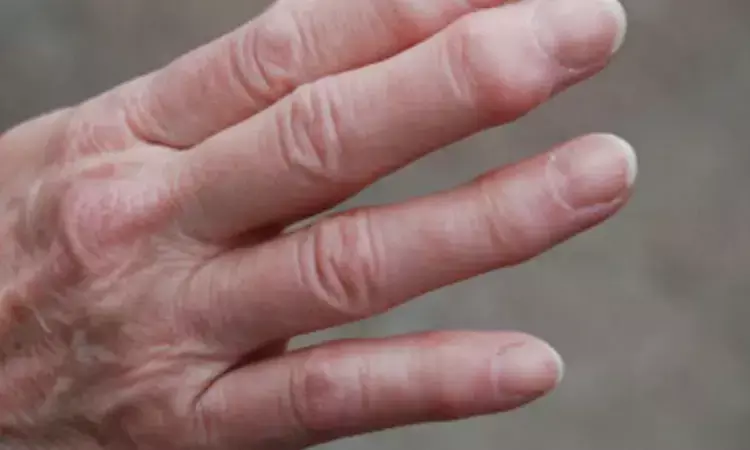- Home
- Medical news & Guidelines
- Anesthesiology
- Cardiology and CTVS
- Critical Care
- Dentistry
- Dermatology
- Diabetes and Endocrinology
- ENT
- Gastroenterology
- Medicine
- Nephrology
- Neurology
- Obstretics-Gynaecology
- Oncology
- Ophthalmology
- Orthopaedics
- Pediatrics-Neonatology
- Psychiatry
- Pulmonology
- Radiology
- Surgery
- Urology
- Laboratory Medicine
- Diet
- Nursing
- Paramedical
- Physiotherapy
- Health news
- Fact Check
- Bone Health Fact Check
- Brain Health Fact Check
- Cancer Related Fact Check
- Child Care Fact Check
- Dental and oral health fact check
- Diabetes and metabolic health fact check
- Diet and Nutrition Fact Check
- Eye and ENT Care Fact Check
- Fitness fact check
- Gut health fact check
- Heart health fact check
- Kidney health fact check
- Medical education fact check
- Men's health fact check
- Respiratory fact check
- Skin and hair care fact check
- Vaccine and Immunization fact check
- Women's health fact check
- AYUSH
- State News
- Andaman and Nicobar Islands
- Andhra Pradesh
- Arunachal Pradesh
- Assam
- Bihar
- Chandigarh
- Chattisgarh
- Dadra and Nagar Haveli
- Daman and Diu
- Delhi
- Goa
- Gujarat
- Haryana
- Himachal Pradesh
- Jammu & Kashmir
- Jharkhand
- Karnataka
- Kerala
- Ladakh
- Lakshadweep
- Madhya Pradesh
- Maharashtra
- Manipur
- Meghalaya
- Mizoram
- Nagaland
- Odisha
- Puducherry
- Punjab
- Rajasthan
- Sikkim
- Tamil Nadu
- Telangana
- Tripura
- Uttar Pradesh
- Uttrakhand
- West Bengal
- Medical Education
- Industry
Swelling and not tenderness of joints better predicts synovitis in psoriatic arthritis

UK: Swollen joints are the better proxy for ultrasound (US) synovitis as compared to tender joints in DMARD-naive early psoriatic arthritis (PsA) patients, states an article published in Rheumatology Advances in Practice.
In Psoriatic Arthritis (PsA), the initial diagnosis and assessment are dependent upon the identification of swollen and tender joints by clinical examination. The tender/swollen joint counts (TJC/SJC) are also key components in composite outcome measures of PsA. Synovitis in PsA may manifest as swelling of joints on clinical examination but PsA patients often report joint pain and may have tender joints without swelling, which may relate to other pathologies.
Ultrasound (US) is increasingly used in PsA diagnosis and management to identify joint synovitis, and peri-tendon/tendon/entheseal inflammation, owing to its superior sensitivity over the clinical examination. Understanding the relationship between clinical joint tenderness/swelling and US synovitis remains crucial for improving the early identification of disease, decision-making, and therapeutic intervention.
Sayam R, University of Leeds, UK, and colleagues conducted a study to determine the association between joint clinical examination findings and US synovitis in early PsA.
Researchers enrolled 155 consecutive disease-modifying antirheumatic drugs (DMARD)-naïve PsA patients for the prospective cohort study. Eligible patients underwent matched clinical/US 44-joint assessment for tender and/or swollen joints (TJ/SJ) and US synovitis [grey scale (GS) ≥ 2 or power Doppler (PD) ≥ 1]. Statistical agreement between TJ/SJ, GS ≥ 2, and PD ≥ 1 was calculated by prevalence-adjusted and bias-adjusted κ (PABAK). To derive probabilities of GS ≥ 2/PD ≥ 1, mixed-effects logistic regression-modeled odds of US synovitis in TJ/SJ were conducted.
Key findings of the study,
• Of the total 5616 joints examined,18.5% were tender, 9.8% were swollen, 20.4% had GS ≥ 2, and 5.2% had PD ≥ 1.
• GS ≥ 2 was most prevalent in concomitantly tender and swollen joints (44%), followed by swollen non-tender joints (36.4%), tender non-swollen joints (25.7%), and non-tender non-swollen joints (subclinical synovitis) (16.9%).
• Agreement between SJ/PD ≥ 1 was high at the individual joint level (PABAK 0.65–0.93) and for total joints combined (PABAK 0.80).
• SJ/GS ≥ 2 agreement was greater than between TJ/GS ≥ 2.
• The swelling was independently associated with higher odds of GS ≥ 2 but not tenderness.
• Swelling or tenderness was independently associated with higher odds of PD ≥ 1.
The authors conclude that synovitis (GS ≥ 2 and/or PD ≥ 1) was more likely in swollen joints than in tender joints in DMARD-naïve, early PsA. The study findings might help to improve the management of early PsA by adding to the understanding of the relation between clinical examination and underlying pathologies in US imaging.
Reference:
Sayam R Dubash, Oras A Alabas, Xabier Michelena, Leticia Garcia-Montoya, et al. Ultrasound shows swollen joints are the better proxy for synovitis than tender joints in DMARD-naïve early psoriatic arthritis, Rheumatology Advances in Practice, Volume 5, Issue 3, 2021, rkab086, https://doi.org/10.1093/rap/rkab086
BDS
Dr. Hiral patel (BDS) has completed BDS from Gujarat University, Baroda. She has worked in private dental steup for 8years and is currently a consulting general dentist in mumbai. She has recently completed her advanced PG diploma in clinical research and pharmacovigilance. She is passionate about writing and loves to read, analyses and write informative medical content for readers. She can be contacted at editorial@medicaldialogues.in.
Dr Kamal Kant Kohli-MBBS, DTCD- a chest specialist with more than 30 years of practice and a flair for writing clinical articles, Dr Kamal Kant Kohli joined Medical Dialogues as a Chief Editor of Medical News. Besides writing articles, as an editor, he proofreads and verifies all the medical content published on Medical Dialogues including those coming from journals, studies,medical conferences,guidelines etc. Email: drkohli@medicaldialogues.in. Contact no. 011-43720751


